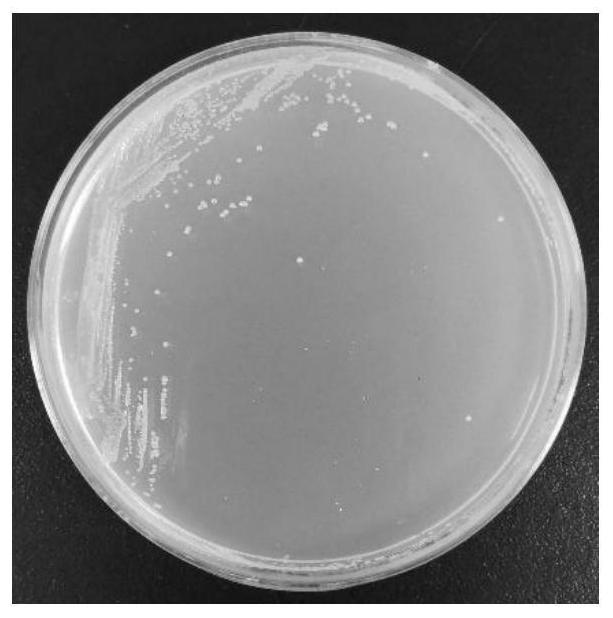Alcaligenes family aerobic new bacterium T-4 and application thereof
A technology of alcaligenes and aerobic bacteria, applied in the direction of aerobic process treatment, bacteria, water/sludge/sewage treatment, etc., can solve the problem of few reports of small molecule degradation products, and achieve the effect of wide application prospects
- Summary
- Abstract
- Description
- Claims
- Application Information
AI Technical Summary
Problems solved by technology
Method used
Image
Examples
Embodiment 1
[0028] Example 1: Enrichment of Compost Samples and Isolation, Purification and Preservation of Terephthalic Acid Degrading Bacteria T-4
[0029] Take 2g of the compost sample and add it to 100mL enrichment medium MMTA, shake and culture at 50°C and 180rpm for one week, detect the TPA concentration before and after the culture of the bacteria solution, if TPA is degraded, dilute the culture solution in a gradient, and spread it on the LBTA medium solid Plates were incubated at 50°C. Pick a single colony, streak it on a new LBTA medium, and further isolate and purify to obtain a single strain. The obtained single strain was re-screened with the enrichment medium, and the strain determined to degrade terephthalic acid was stored in a glycerol tube with a final concentration of 20% glycerol, and stored in a -80°C refrigerator.
Embodiment 2
[0030] Embodiment 2: the strain identification of bacterial strain T-4
[0031] (1) Morphological characteristics of bacterial colonies
[0032] After the strain T-4 was cultured in LBTA solid medium at 50°C for 3 days, the colony was off-white, round, convex and smooth, with neat edges, see figure 1 .
[0033] (2) Morphological characteristics of the bacteria
[0034] The transmission electron microscope image of the strain T-4 cultured in the improved MMTA liquid medium at 50°C and 180rpm for 18 hours. The cells are spherical or slightly ellipsoidal in shape, with a diameter of 1.08-1.4 μm. They have flagella, and the flagella are multiple and implanted in different positions. fixed, see figure 2 , where A-F represent different cells, and the magnifications of A, B, C-E, and F are 1.5k, 2.0k, 3.0k, and 4.0k, respectively.
[0035] (3) Taxonomic status of strain T-4
[0036] The bacterial genomic DNA extraction kit (Axgen) was used to extract the total DNA of strain T-4...
Embodiment 3
[0042] Example 3: Degradation of TPA by bacterial strain T-4
[0043] (1) Growth curve of strain T-4 degrading TPA
[0044] Bacterial strain T-4 was cultivated in the improved MMTA liquid medium, the filling volume of 250mL shake flask was 100mL, 1% inoculum size, 50°C and 180rpm shaking culture, and samples were taken at different time points to detect the bacterial concentration (OD 600 ), TPA concentration and pH. The concentration of terephthalic acid in each group was determined by ultraviolet-visible spectrophotometry: after the samples were centrifuged at 10,000 rcf for 2 minutes, the optical density OD of the supernatant of the bacterial liquid was detected 240 , it is necessary to make a standard curve with MMTA solutions of different terephthalic acid concentrations.
[0045] The growth curve of strain T-4 degrading TPA is as follows Figure 4 As shown, the strain T-4 grows gradually with the degradation of terephthalic acid, and the pH will increase during the de...
PUM
 Login to View More
Login to View More Abstract
Description
Claims
Application Information
 Login to View More
Login to View More - R&D
- Intellectual Property
- Life Sciences
- Materials
- Tech Scout
- Unparalleled Data Quality
- Higher Quality Content
- 60% Fewer Hallucinations
Browse by: Latest US Patents, China's latest patents, Technical Efficacy Thesaurus, Application Domain, Technology Topic, Popular Technical Reports.
© 2025 PatSnap. All rights reserved.Legal|Privacy policy|Modern Slavery Act Transparency Statement|Sitemap|About US| Contact US: help@patsnap.com



